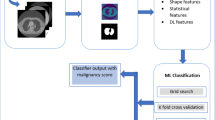Abstract
The LIDC-IDRI database is the most popular benchmark for lung cancer prediction. However, with subjective assessment from radiologists, nodules in LIDC may have entirely different malignancy annotations from the pathological ground truth, introducing label assignment errors and subsequent supervision bias during training. The LIDC database thus requires more objective labels for learning-based cancer prediction. Based on an extra small dataset containing 180 nodules diagnosed by pathological examination, we propose to re-label LIDC data to mitigate the effect of original annotation bias verified on this robust benchmark. We demonstrate in this paper that providing new labels by similar nodule retrieval based on metric learning would be an effective re-labeling strategy. Training on these re-labeled LIDC nodules leads to improved model performance, which is enhanced when new labels of uncertain nodules are added. We further infer that re-labeling LIDC is current an expedient way for robust lung cancer prediction while building a large pathological-proven nodule database provides the long-term solution.
Access this chapter
Tax calculation will be finalised at checkout
Purchases are for personal use only
Similar content being viewed by others
References
Armato, S.G., III., et al.: The lung image database consortium (LIDC) and image database resource initiative (IDRI): a completed reference database of lung nodules on CT scans. Med. Phys. 38(2), 915–931 (2011)
Bellet, A., Habrard, A., Sebban, M.: Metric Learning. Synthesis Lectures on Artificial Intelligence and Machine Learning, vol. 9, no. 1, pp. 1–151 (2015)
Guo, Q., Feng, W., Zhou, C., Huang, R., Wan, L., Wang, S.: Learning dynamic siamese network for visual object tracking. In: Proceedings of the IEEE International Conference on Computer Vision, pp. 1763–1771 (2017)
Han, F., et al.: Texture feature analysis for computer-aided diagnosis on pulmonary nodules. J. Digit. Imaging 28(1), 99–115 (2015)
He, K., Zhang, X., Ren, S., Sun, J.: Deep residual learning for image recognition. In: Proceedings of the IEEE Conference on Computer Vision and Pattern Recognition, pp. 770–778 (2016)
Hussein, S., Cao, K., Song, Q., Bagci, U.: Risk stratification of lung nodules using 3D CNN-based multi-task learning. In: Niethammer, M., et al. (eds.) IPMI 2017. LNCS, vol. 10265, pp. 249–260. Springer, Cham (2017). https://doi.org/10.1007/978-3-319-59050-9_20
Kaya, M., Bilge, H.Ş: Deep metric learning: a survey. Symmetry 11(9), 1066 (2019)
Kingma, D.P., Ba, J.: Adam: a method for stochastic optimization. ar**v preprint ar**v:1412.6980 (2014)
Koch, G., Zemel, R., Salakhutdinov, R.: Siamese neural networks for one-shot image recognition. In: ICML Deep Learning Workshop, vol. 2. Lille (2015)
Kramer, B.S., Berg, C.D., Aberle, D.R., Prorok, P.C.: Lung cancer screening with low-dose helical CT: results from the national lung screening trial (NLST) (2011)
Liao, Z., **e, Y., Hu, S., **a, Y.: Learning from ambiguous labels for lung nodule malignancy prediction. ar**v preprint ar**v:2104.11436 (2021)
Liu, L., Dou, Q., Chen, H., Qin, J., Heng, P.A.: Multi-task deep model with margin ranking loss for lung nodule analysis. IEEE Trans. Med. Imaging 39(3), 718–728 (2019)
McNitt-Gray, M.F., et al.: The lung image database consortium (LIDC) data collection process for nodule detection and annotation. Acad. Radiol. 14(12), 1464–1474 (2007)
Setio, A.A.A., et al.: Validation, comparison, and combination of algorithms for automatic detection of pulmonary nodules in computed tomography images: the LUNA16 challenge. Med. Image Anal. 42, 1–13 (2017)
Shen, W., et al.: Learning from experts: develo** transferable deep features for patient-level lung cancer prediction. In: Ourselin, S., Joskowicz, L., Sabuncu, M.R., Unal, G., Wells, W. (eds.) MICCAI 2016. LNCS, vol. 9901, pp. 124–131. Springer, Cham (2016). https://doi.org/10.1007/978-3-319-46723-8_15
Shen, W., Zhou, M., Yang, F., Yang, C., Tian, J.: Multi-scale convolutional neural networks for lung nodule classification. In: Ourselin, S., Alexander, D.C., Westin, C.-F., Cardoso, M.J. (eds.) IPMI 2015. LNCS, vol. 9123, pp. 588–599. Springer, Cham (2015). https://doi.org/10.1007/978-3-319-19992-4_46
Shen, W., et al.: Multi-crop convolutional neural networks for lung nodule malignancy suspiciousness classification. Pattern Recogn. 61, 663–673 (2017)
National Lung Screening Trial Research Team: The national lung screening trial: overview and study design. Radiology 258(1), 243–253 (2011)
National Lung Screening Trial Research Team: Reduced lung-cancer mortality with low-dose computed tomographic screening. N. Engl. J. Med. 365(5), 395–409 (2011)
Wu, B., Sun, X., Hu, L., Wang, Y.: Learning with unsure data for medical image diagnosis. In: Proceedings of the IEEE International Conference on Computer Vision, pp. 10590–10599 (2019)
Wu, B., Zhou, Z., Wang, J., Wang, Y.: Joint learning for pulmonary nodule segmentation, attributes and malignancy prediction. In: 2018 IEEE 15th International Symposium on Biomedical Imaging (ISBI 2018), pp. 1109–1113. IEEE (2018)
Wu, Y., He, K.: Group normalization. In: Proceedings of the European Conference on Computer Vision (ECCV), pp. 3–19 (2018)
**e, Y., et al.: Knowledge-based collaborative deep learning for benign-malignant lung nodule classification on chest CT. IEEE Trans. Med. Imaging 38(4), 991–1004 (2018)
Zhang, H., Gu, Y., Qin, Y., Yao, F., Yang, G.-Z.: Learning with sure data for nodule-level lung cancer prediction. In: Martel, A.L., et al. (eds.) MICCAI 2020. LNCS, vol. 12266, pp. 570–578. Springer, Cham (2020). https://doi.org/10.1007/978-3-030-59725-2_55
Acknowledgments
This work was partly supported by Medicine-Engineering Interdisciplinary Research Foundation of Shanghai Jiao Tong University (YG2021QN128), Shanghai Sailing Program (20YF1420800), National Nature Science Foundation of China (No.62003208), Shanghai Municipal of Science and Technology Project (Grant No. 20JC1419500), and Science and Technology Commission of Shanghai Municipality (Grant 20DZ2220400).
Author information
Authors and Affiliations
Corresponding authors
Editor information
Editors and Affiliations
Rights and permissions
Copyright information
© 2022 The Author(s), under exclusive license to Springer Nature Switzerland AG
About this paper
Cite this paper
Zhang, H. et al. (2022). Re-thinking and Re-labeling LIDC-IDRI for Robust Pulmonary Cancer Prediction. In: Zamzmi, G., Antani, S., Bagci, U., Linguraru, M.G., Rajaraman, S., Xue, Z. (eds) Medical Image Learning with Limited and Noisy Data. MILLanD 2022. Lecture Notes in Computer Science, vol 13559. Springer, Cham. https://doi.org/10.1007/978-3-031-16760-7_5
Download citation
DOI: https://doi.org/10.1007/978-3-031-16760-7_5
Published:
Publisher Name: Springer, Cham
Print ISBN: 978-3-031-16759-1
Online ISBN: 978-3-031-16760-7
eBook Packages: Computer ScienceComputer Science (R0)





